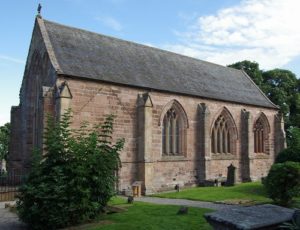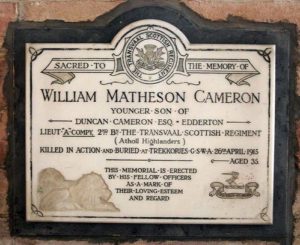Tain was an important place of pilgrimage in the middle ages. St Duthac was born here about 1000AD. He was educated in Ireland and became a Celtic missionary. He died in 1065 and in 1253, his relics were returned to Tain and buried in the small chapel on the north east side of the town. Tales of miracles soon grew up round him and St Duthac’s chapel. It rapidly became one of the most important places of pilgrimage and sanctuary in Scotland. In 1427 the chapel was burnt down and his remains were transferred to the Collegiate Church in the centre of town. They disappeared during the reformation. The Collegiate church was abandoned in 1815 when a larger church was built to replace it.
The Collegiate Church of St Duthac set in a grassy kirkyard at the back of high Street.
The Collegiate church is a long rectangular building with a small bell cot, built between 1370-1460. It became an important place of pilgrimage after St Duthac’s remains were transferred here. After the Reformation the saying of masses ceased, the trappings of pilgrimage were removed as well as the altar and it became the parish church. A large pulpit was installed on the south wall. As the population of Tain increased, additional lofts (galleries) reached by outside stairs were added round the walls. Eventually the church became too small and was abandoned after a larger church was built.
The galleries have been removed and the building restored. It is used occasionally for weddings and concerts.
Entry is through the south door with two small heads carved on either side. Inside it as a big barn of a place with a wood beam roof and bare stone walls. The nave is bare apart from two old benches against the walls and chairs stacked up. On the south wall is the massive wooden pulpit, a 19thC reconstruction of the original, with steps and a massive canopy. There is the remains of a sedillia on the south wall and aumbries on the north wall, survivors of the medieval building.
Hanging up on the north wall is the front of the 17thC guild’s loft which was used by the different craftsmen and their gild emblems were painted along the front. The loft has long gone but the front remains, a rare survival and the only complete example in Scotland.
Below it is a brass memorial with a long list of names of those who died in the First World War with a smaller plate below to those who died in the Second World War. Beneath this and hidden behind stacked chairs is the remains of a wall tomb with the carving of a bishop. There are other stone and marble memorials round the walls including one to William Matheson Cameron a soldier in the Transvaal Scottish Regiment, who died in German South West Africa in 1915. You learn a lot of geography and history from these memorials.
There is a large stained glass window at the east end. Below are two decorated arches surrounding marble memorial stones. One is for Patrick Hamilton, Abbot, who was the first preacher of the Reformation in Scotland and burnt at the stake in St Andrews in 1528. The other is to Thomas Hoc who was removed as minister for his “loyalty to Christ’s Crown and the Covenant” in 1662. He became a friend and supporter of William of Orange and was eventually restored to the parish in 1690, dying two years later. I do love these old memorial stones and their history.









